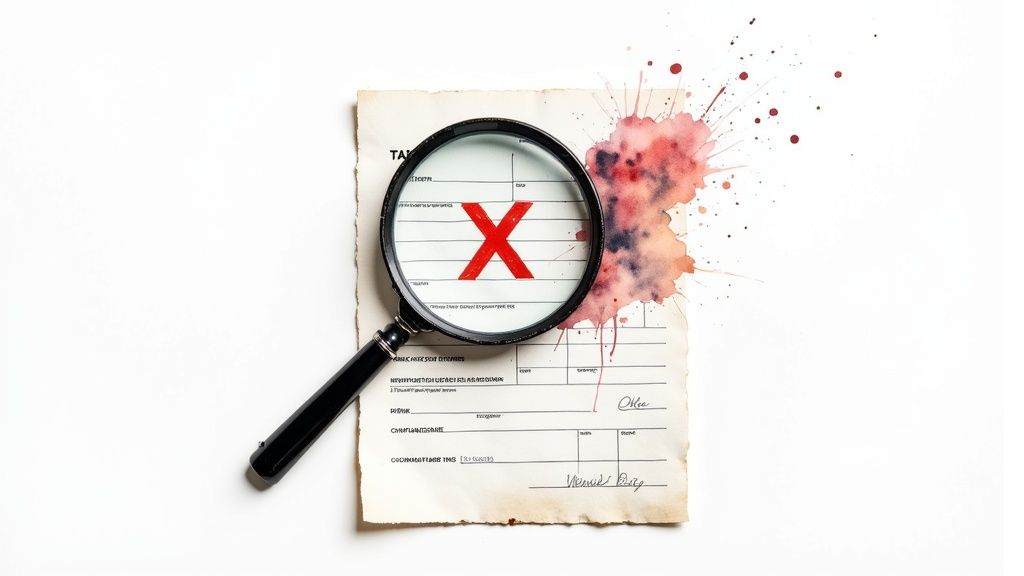Maximize Your Work From Home Tax Deductions Today
Max
One of the most valuable perks of self-employment is the ability to claim work-from-home tax deductions. But this benefit is almost exclusively for self-employed individuals, like freelancers and independent contractors. Thanks to some big tax law changes, if you’re a traditional W-2 employee working remotely for a company, you generally can’t claim this deduction anymore.
Who Actually Qualifies For This Deduction

The first question every remote worker asks is, “So, can I actually get these savings?” The answer comes down to one crucial thing: your employment status. Getting this right is the absolute foundation for claiming any work-from-home tax write-offs.
A massive shift happened with the Tax Cuts and Jobs Act of 2017. This law essentially put a pause on miscellaneous itemized deductions for employees from 2018 through 2025. For folks in the United States, this means the home office deduction is now a tax benefit mainly for the self-employed crowd. W-2 employees just can’t claim it for their work-related expenses right now.
This change puts the spotlight squarely on:
- Freelancers
- Independent contractors
- Gig economy workers
- Small business owners
If you get a 1099-NEC form instead of a W-2, you’re on the right track. This shift also casts a light on the many other benefits of working remotely, which often include more financial control and freedom.
To give you a clearer picture, let’s break down who gets to claim this deduction and who doesn’t.
Employee vs Self-Employed Deduction Eligibility
| Taxpayer Type | Can Claim Home Office Deduction? | Key Reason |
|---|---|---|
| Self-Employed (1099) | Yes | Considered ordinary and necessary business expenses. |
| W-2 Employee | No (for federal taxes) | Miscellaneous itemized deductions were suspended by the TCJA of 2017. |
Ultimately, it all boils down to whether the IRS views you as running your own business from home.
The Two Pillars of IRS Eligibility
To successfully claim this deduction, you have to meet two core requirements from the IRS. Think of them as non-negotiable rules that prove your home workspace is a real business expense and not just a personal convenience.
First up is the “regular and exclusive use” test. This means the specific part of your home you’re claiming must be used only for your business. It can’t be a guest room on weekends or a playroom for the kids in the afternoon.
Think of it like a dedicated tool in a workshop. A carpenter’s table saw is only used for cutting wood for projects; you wouldn’t use it to slice bread for dinner. Your office space needs that same level of single-minded purpose.
Your Principal Place of Business
The second requirement is the “principal place of business” test. Your home office has to be the main spot where you get your business done. It’s where you handle administrative work, meet clients, or create your products.
The IRS needs to see that your home is the central hub of your business operations. If you have another primary office or location where you do most of your work, your home space might not qualify.
For example, a freelance graphic designer who does all their projects, sends invoices, and talks to clients from their home desk clearly meets this standard. On the other hand, a plumber who is out at client sites all day and just uses a home desk for an hour of paperwork at night might have a tougher time proving it. You have to satisfy both rules to make sure your claim is valid and can stand up to an audit.
Choosing Your Calculation Method: Simplified vs. Regular
Okay, so you’ve confirmed you’re eligible for the home office deduction. Now comes the big decision: how are you actually going to calculate it? The IRS gives you two ways to play this, and your choice can make a huge difference to your bottom line.
Think of it like this: you can either take a standard, one-size-fits-all deduction that’s quick and easy, or you can roll up your sleeves, track your actual expenses, and potentially claim a much larger amount. Neither is wrong—it just depends on what makes the most sense for your situation.
The Simplified Method: Quick, Easy, and Done
The Simplified Method is exactly what it sounds like. It’s the express lane for your home office deduction. If the thought of digging through a year’s worth of utility bills and repair receipts makes you want to run for the hills, this is probably your best friend.
Instead of adding up every single expense, you just use a flat rate set by the IRS.
The formula couldn’t be easier: you deduct $5 per square foot of your home office. That’s it. There is a catch, though—the space is capped at 300 square feet, which means your maximum possible deduction using this method is $1,500 per year.
Here’s why people love it:
- Almost Zero Record-Keeping: Forget about saving every hydro bill or insurance statement for this specific deduction.
- Saves a Ton of Time: The math takes about 30 seconds. No spreadsheets, no calculators, no headaches.
- Crystal Clear Limit: You know exactly what you’re getting. The max is $1,500, period.
For example, say you’re a freelance writer with a 120-square-foot office nook. Your deduction is simply 120 sq ft x $5 = $600. It’s clean, fast, and gives you a solid tax break without the administrative hassle.
The bottom line? The Simplified Method is perfect if you have a small office, your actual home expenses are pretty low, or you just value your time more than squeezing every last penny out of your return.
But what if you look at that $1,500 cap and think, “I’m definitely spending more than that”? Well, that’s when you bring out the big guns.
The Regular Method: More Work for a Bigger Payoff
This is where the real magic can happen. The Regular Method is for the meticulous record-keeper who wants to maximize their deduction. It requires more effort, but the payout can be significantly higher, especially if you have a larger office or live in a high-cost area.
With this method, you calculate the percentage of your home that’s used for business and then apply that percentage to all your actual home-related expenses.
First, you need your business-use percentage. The most common way to do this is with the area method: just divide your office’s square footage by your home’s total square footage.
- Quick Example: Let’s say your home office is a 250-square-foot spare room in a 1,250-square-foot apartment.
- The Math: (250 sq ft / 1,250 sq ft) = 0.20
- Your Percentage: Your business-use percentage is 20%.
Now, you get to apply that 20% to a whole host of household expenses. Things like:
- Rent or mortgage interest
- Utilities (electricity, gas, water, internet)
- Homeowners or renters insurance
- Property taxes (if you own your home)
- General home repairs and maintenance (like fixing the furnace or a leaky roof)
Let’s go back to our freelance writer. Their office is 250 square feet (20% business use). If their total annual rent, utilities, and insurance comes to $30,000, their deduction would be $30,000 x 20% = $6,000.
That’s a $4,500 difference compared to the Simplified Method’s cap. Suddenly, tracking those receipts doesn’t seem like such a bad idea, does it?
Uncovering Every Deductible Home Office Expense

Alright, you’ve picked your calculation method. Now for the fun part: finding all the hidden savings by tracking down every single expense you can claim. Think of it like a treasure hunt, but instead of gold, you’re finding cash to put back in your pocket.
When it comes to home office deductions, expenses fall into two main buckets: direct and indirect costs. Getting the hang of the difference between these two is the secret to using the Regular Method correctly and getting the biggest possible tax return.
H3: Indirect Expenses: The Costs of Running Your Whole Home
Indirect expenses are all the costs that keep your entire home up and running. Because your business benefits from the roof over its head (literally), you can write off a portion of these costs. This is where that business-use percentage you calculated really starts to work its magic.
You’ll apply that percentage to a whole host of household bills. Here are some of the most common ones you shouldn’t overlook:
- Rent or Mortgage Interest: Renters can deduct a piece of their monthly payment. Homeowners get to deduct a percentage of the mortgage interest paid over the year.
- Property Taxes: If you own your home, that same business-use percentage can be applied to your annual property tax bill.
- Homeowners or Renters Insurance: The policy protecting your whole home also covers your business assets inside it, so a portion of that premium is fair game.
- Utilities: This covers everything from electricity and gas to water and trash removal. They’re all essential for your home, which means they’re essential for your workspace, too.
- General Home Repairs: Did you have to get the furnace fixed or patch a leaky roof? Since these repairs benefit the entire house, a percentage of their cost is deductible.
Let’s say your business-use percentage is 15%. If your total electricity bill for the year was $1,200, you could deduct $180 as a business expense. On their own, these numbers might seem small, but they add up fast when you tally them all together.
H3: Direct Expenses: Costs That Are 100% for Your Office
Direct expenses are much more straightforward. These are costs that are exclusively for your home office, with absolutely no personal use mixed in. Because they are 100% for your business, you get to deduct the full amount—no percentage calculation needed.
Think of anything you bought specifically and solely for your workspace.
A perfect example is painting your office. If you only buy paint and supplies to freshen up the walls of your dedicated workspace, that entire cost is a direct expense you can deduct in full. But if you painted the whole house, it flips back to being an indirect expense.
Other clear-cut examples of direct expenses include:
- Repairs made only inside your office, like fixing a faulty light fixture.
- Installing a dedicated business phone line that runs straight to your office.
- Buying furniture like a desk, chair, or filing cabinet that is only used for work.
To really get a feel for the full scope of potential write-offs, it helps to see a complete list. This overview of the Tax Implications Of Working From Home Deductions You Can Claim does an excellent job of breaking it all down.
Below is a table that organizes some of the most common expenses you’ll encounter.
Common Deductible Expenses for Your Home Business
This table breaks down the types of expenses you can claim, separating them into direct, indirect, and other common business costs to help you categorize everything properly.
| Expense Category | Examples | Deductibility Notes |
|---|---|---|
| Direct Expenses | Office furniture (desk, chair), office-specific repairs, dedicated business phone line, office supplies. | 100% deductible. These costs are solely for your business space and have no personal use. You can claim the full amount without applying your business-use percentage. |
| Indirect Expenses | Rent, mortgage interest, property taxes, utilities (electricity, gas), homeowners insurance, general home repairs. | Partially deductible. These costs are for maintaining your entire home. You must multiply the total cost by your home office’s business-use percentage to find the deductible amount. |
| Other Business Expenses | Business software subscriptions, professional development courses, business travel, marketing costs, internet service. | Varies. Many of these are 100% deductible (like software). For shared services like the internet, you must determine a reasonable business-use percentage and deduct that portion of the cost. Keep detailed records to justify your claims for these types of expenses. |
Using a table like this can be a great way to make sure you don’t miss anything when it’s time to file.
H3: What About Shared Services Like Internet and Phone?
One of the biggest questions people have is about shared services. How do you handle your internet bill when the whole family streams movies on it? Thankfully, the IRS lets you deduct the business portion of these bills.
The key is to come up with a reasonable estimate of how much you use it for work versus personal stuff. For example, if you’re self-employed and your internet bill is $100 a month, and you figure about 60% of your time online is for business, you could potentially deduct $60 each month.
The same logic works for your personal cell phone if you use it for work calls and emails. A good practice is to keep a log for a month or two to establish a solid business-use percentage you can confidently defend if asked.
And don’t forget other vital business costs that are fully deductible on their own, like business software, office supplies, and professional development courses. Investing in your workspace is also a smart move—a proper ergonomic home office setup isn’t just good for your back, it can be a good financial decision, too.
How This Deduction Works with Your Personal Taxes

One of the biggest questions I hear from newly self-employed people is about where the home office deduction actually fits into their tax return. Does claiming it lock you into itemizing your personal deductions? Do you lose the simplicity of the standard deduction?
Let’s clear the air on that right now.
Think of your tax return as having two separate-but-connected buckets: your personal tax world (Form 1040) and your business tax world (Schedule C). The home office deduction lives squarely in the business bucket. It’s not a personal itemized deduction like mortgage interest or charitable donations.
Instead, it’s a legitimate business expense, just like paying for software or running an ad campaign. You calculate it on IRS Form 8829, and that final number gets plugged right into your Schedule C, “Profit or Loss from Business.” This distinction is a game-changer.
It’s About Reducing Business Profit, Not Personal Deductions
Because the home office deduction is treated as a business expense, its main job is to shrink your business’s net profit. This is powerful because it lowers the amount of income subject to self-employment taxes (that pesky 15.3% for Social Security and Medicare) and, by extension, your overall income tax.
This whole process happens before you even think about taking the standard deduction or itemizing on your personal return. This is fantastic news.
What this really means is you get the best of both worlds. You can use the home office deduction to knock down your taxable business income and still take the full standard deduction on your personal Form 1040.
This separation is a massive advantage for freelancers and entrepreneurs. It lets you maximize your business write-offs without messing up your personal filing strategy. Getting your head around how these pieces connect is a huge step in mastering remote work taxes.
A Real-World Example in Action
Let’s walk through a quick scenario. Meet Alex, a freelance web developer.
- Business Income: Alex brought in $80,000 from client projects this year.
- Other Business Expenses: Alex spent $10,000 on things like software subscriptions and advertising.
- Home Office Deduction: Using the Regular Method, Alex calculated a $6,000 deduction for their dedicated home office.
- Total Business Expenses: That brings Alex’s total business expenses to $16,000 ($10,000 + $6,000).
- Net Business Profit: So, the final profit reported on Schedule C is $64,000 ($80,000 - $16,000).
That $64,000 is the magic number that flows from Alex’s business over to the personal tax return. On that personal side, Alex is completely free to take the standard deduction.
For the 2025 tax year, the standard deduction is projected to be $15,750 for single filers and $31,500 for married couples filing jointly. Since the home office deduction was already handled on the business side, it has no impact on these personal deduction amounts.
This simple two-step process really demystifies how the deduction works. It’s a business tool that cuts your business profit, which then lowers your personal tax bill—all without forcing you to give up the standard deduction.
Building an Audit-Proof Record-Keeping System
Claiming work-from-home tax deductions is only half the battle. The real test comes if the IRS ever decides to take a closer look. An audit notice can sound terrifying, but with a solid record-keeping system, it’s really just a request for information you already have on hand.
Think of your records like the foundation of a house. If they’re strong, organized, and complete, your tax claims can withstand any scrutiny. The goal isn’t to create some complex, time-consuming chore. Instead, you want to build a simple, sustainable habit that makes tax time a breeze and keeps you prepared for anything.
Your Essential Document Checklist
Good records are specific and complete. Vague credit card statements just won’t cut it; you need detailed proof for every single expense you claim. The first step is to create a dedicated folder—either physical or digital—for all your business-related documents.
Here’s what you absolutely must keep to back up your work-from-home tax deductions:
- Proof of Home Expenses: This includes your utility bills (electricity, gas, water), internet bills, homeowners or renters insurance statements, and property tax records. If you own your home, make sure you have copies of your mortgage interest statements (Form 1098).
- Receipts for Direct Expenses: Save every single receipt for purchases made exclusively for your office. This means the receipt for that new ergonomic chair, your desk, printer ink, and even the paint you used to freshen up the room.
- Records of Repairs: Keep all invoices and proof of payment for any repairs. If it’s a direct expense (like fixing a broken window in your office), the whole cost is deductible. If it’s an indirect one (like a new furnace for the whole house), you’ll need that record to calculate the business portion correctly.
The golden rule of record-keeping is simple: when in doubt, save it. It is far better to have a receipt you don’t end up needing than to need a receipt you don’t have.
This organized approach isn’t just about taxes; it’s one of the most important remote work best practices for any self-employed professional, ensuring you have total financial clarity.
Documenting Exclusive and Regular Use
Proving your expenses is one piece of the puzzle. Proving you meet the IRS’s “exclusive and regular use” test is the other. The government needs to see that your space is genuinely used as a dedicated place of business, not just your kitchen table after dinner.
Fortunately, documenting this is easier than you might think. A simple but powerful strategy is to take dated photos of your workspace at the beginning of each year. A clear picture showing your desk, computer, and other business equipment in a defined area serves as excellent visual proof that the space is set up and used for work.
Another great practice is to maintain a simple log or just use a digital calendar to note the days you worked from your home office. This helps establish a clear pattern of regular use, reinforcing that it’s not just a place you occasionally answer emails.
Modern Tools to Simplify Your System
Gone are the days of stuffing faded receipts into a shoebox. Today’s tools can make tracking expenses almost automatic, turning a dreaded task into a manageable habit.
- Dedicated Business Bank Account: Honestly, this is non-negotiable. Running all your business income and expenses through one account creates a clean, easy-to-follow financial trail. It’s the clearest way to separate your business and personal life.
- Expense Tracking Apps: Tools like Keeper Tax, QuickBooks Self-Employed, or Wave can sync directly with your business account. They automatically categorize expenses and capture digital receipts, which eliminates tedious manual entry and reduces the risk of missing a valuable deduction.
- Simple Spreadsheet Templates: If you prefer a more hands-on approach, a well-organized spreadsheet is perfectly effective. Just create columns for the date, expense category, vendor, amount, and a brief note about its business purpose.
By combining these elements—a clear checklist, solid proof of use, and modern tools—you build a system that not only maximizes your deductions but gives you complete confidence. With organized records, you can claim every penny you deserve without ever losing sleep over an audit.
Answering Your Top Home Office Deduction Questions

Even after you get the hang of the basics, the “what if” scenarios always seem to pop up. Applying the rules for work-from-home tax deductions to your unique, real-life situation can feel a little tricky.
Let’s tackle some of the most common questions we see from self-employed professionals. The goal here is to give you clear, direct answers so you can feel confident you’re getting it right.
Can I Claim the Deduction If My Office Is in a Shared-Use Room?
This is a big one, and the short answer is usually no. The IRS is notoriously strict about the “exclusive use” test. This means the space you’re claiming has to be used only for your business. Period.
That desk tucked into the corner of your guest bedroom? It probably won’t qualify if that room also hosts your in-laws twice a year. The key is that absolutely zero personal activity happens in the specific area you measure for the deduction.
However, you can claim a piece of a larger room if you create a clearly defined, separately identifiable business zone. Think of it like this: if you partition off a section of your basement exclusively for your work—and it’s never used for laundry, storage, or as a play area—that specific section can qualify.
What Happens If My Business Has a Loss for the Year?
This is a critical point. Your home office deduction is a powerful tool, but it can’t be used to create or increase a business loss on your tax return. The deduction is limited to your business’s gross income minus all your other business expenses.
Let’s walk through an example. Say your business has a net income of $2,000 before you factor in your home office deduction, which you’ve calculated to be $3,500. You can only deduct $2,000 for this year, bringing your business profit down to zero.
But don’t worry—the remaining $1,500 isn’t gone forever. The good news is that you can carry forward that unused portion to the next tax year. You can then apply it against that year’s income, as long as your business turns a profit.
How Do I Calculate Deductions If I Started My Business Mid-Year?
If your business wasn’t up and running for the full 12 months, you’ll need to prorate your expenses. It makes sense, right? You can only deduct costs that cover the period your home office was actually being used for your business.
For instance, if you launched your freelance career on August 1st, you’d only count the expenses from August through December.
- For the Regular Method: You’d figure out your total annual indirect costs (like rent, utilities, insurance) and then use only the portion from those five months in your final calculation.
- For the Simplified Method: You’d simply calculate your deduction based on the number of months the space was in use. If your office is 100 sq. ft., your math would look like 100 sq. ft. x $5 x 5 months (not 5⁄12).
This step ensures your claim is an accurate reflection of your business’s real-world timeline. It’s a crucial detail to get right when you figure out https://remotefirstjobs.com/blog/how-to-find-remote-work and officially make the jump to self-employment.
Does Taking the Home Office Deduction Raise My Audit Risk?
This myth just won’t die, and it causes a lot of unnecessary anxiety. Decades ago, the home office deduction might have been seen as an audit red flag, but that’s simply not the case anymore.
The explosion of the gig economy and remote entrepreneurship has made this deduction incredibly common. The IRS is far more interested in catching fraudulent or wildly exaggerated claims, not legitimate ones from hardworking people like you.
As long as you meet the strict eligibility tests, calculate everything accurately, and—most importantly—keep meticulous records to back it all up, you should feel completely confident. Solid documentation is your best defense and the key to total peace of mind.


